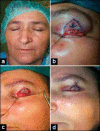Reconstruction of periorbital region defects: A retrospective study
- PMID: 24987598
- PMCID: PMC4073462
- DOI: 10.4103/2231-0746.133077
Reconstruction of periorbital region defects: A retrospective study
Abstract
Background: Although the periorbital region forms less than 1% of the total body surface, it has a very complex anatomy; therefore, it requires a detailed approach. In this work, we aim to present the clinical applications and related literature for the algorithm of the technique which will be applied, according to the location of the defect, in choosing the surgery treatment method. Factors affecting the results and different treatment methods of the anatomical region, including its difficult reconstruction, will also be included.
Materials and methods: A review of 177 periorbital region defect reconstructions was performed.
Results: As a treatment method, in 76 (43%) patients primary closure was chosen, 39 (22%) patients had grafts and in 62 (35%) patients a flap was chosen as a treatment alternative. With respect to postoperative complications, there were a total of 6 (3.38%) patients observed with venous congestion. In 11 (6.21%) patients ectropion developed, in 1 (0.56%) patient minimal space between the eyelids while monitoring recovery was observed and in 1 (0.56%) patient, flap loss was observed due to a circulatory disorder.
Conclusions: The aim of reconstruction is to repair the defect suitable to normal physiological and anatomical values. As a result, before the surgical treatments in this difficult anatomical region, the defect width and anatomical localization must be evaluated. The most suitable reconstruction method must be identified, using an evaluation of the algorithm and the required functional and esthetical results can be obtained with intraoperative flexible behavior and a change of method, when necessary.
Keywords: Algorithm; periorbital defects; reconstruction.
Conflict of interest statement
Figures




Similar articles
-
Usefulness of the orbicularis oculi myocutaneous flap in periorbital reconstruction.Arch Craniofac Surg. 2018 Dec;19(4):254-259. doi: 10.7181/acfs.2018.02019. Epub 2018 Dec 27. Arch Craniofac Surg. 2018. PMID: 30613086 Free PMC article.
-
Reconstruction of Full-Thickness Eyelid Defects Following Malignant Tumor Excision: The Retroauricular Flap and Palatal Mucosal Graft.J Craniofac Surg. 2016 May;27(3):612-4. doi: 10.1097/SCS.0000000000002543. J Craniofac Surg. 2016. PMID: 27054433
-
Reconstruction of periorbital defects using a modified Tenzel flap.Arch Craniofac Surg. 2020 Feb;21(1):35-40. doi: 10.7181/acfs.2019.00577. Epub 2020 Feb 20. Arch Craniofac Surg. 2020. PMID: 32126618 Free PMC article.
-
Intraoperative superficial inferior epigastric vein preservation for venous compromise prevention in breast reconstruction by deep inferior epigastric perforator flap.Ann Chir Plast Esthet. 2019 Jun;64(3):245-250. doi: 10.1016/j.anplas.2018.09.004. Epub 2018 Oct 13. Ann Chir Plast Esthet. 2019. PMID: 30327210 Review.
-
Guidelines for reconstruction of the eyelids and canthal regions.J Plast Reconstr Aesthet Surg. 2010 Sep;63(9):1420-33. doi: 10.1016/j.bjps.2009.05.035. Epub 2009 Jun 25. J Plast Reconstr Aesthet Surg. 2010. PMID: 19559662 Review.
Cited by
-
The Prevalence and Treatment Costs of Non-Melanoma Skin Cancer in Cluj-Napoca Maxillofacial Center.Medicina (Kaunas). 2023 Jan 23;59(2):220. doi: 10.3390/medicina59020220. Medicina (Kaunas). 2023. PMID: 36837422 Free PMC article.
-
Periorbital Trauma: A New Classification.Craniomaxillofac Trauma Reconstr. 2019 Sep;12(3):228-240. doi: 10.1055/s-0039-1677808. Epub 2019 Jan 30. Craniomaxillofac Trauma Reconstr. 2019. PMID: 31428248 Free PMC article.
References
-
- Codner MA. Reconstruction of the eyelids and orbit. In: Coleman JJ 3rd, editor. Plastic Surgery Indications, Operations and Outcomes. Ch. 87. Vol. 3. St. Louis: Mosby; 2000. pp. 1425–64. Sayfa.
-
- Spinelli HM, Jelks GW. Periocular reconstruction: A systematic approach. Plast Reconstr Surg. 1993;91:1017–24. - PubMed
-
- Köse R. Periorbital yumuşak dokuların onarımı. Fırat Tıp Derg. 2005;10:12–7.
-
- Patel BC, Flaharty PM, Anderson RL. Reconstruction of the eyelids. In: Baker SR, Swanson NA, editors. Local Flaps in Facial Reconstruction. Ch. 16. St. Louis: Mosby; 1995.
-
- Demir Z, Yüce S, Karamürsel S, Celebioglu S. Orbicularis oculi myocutaneous advancement flap for upper eyelid reconstruction. Plast Reconstr Surg. 2008;121:443–50. - PubMed
LinkOut - more resources
Full Text Sources
Other Literature Sources
Research Materials

